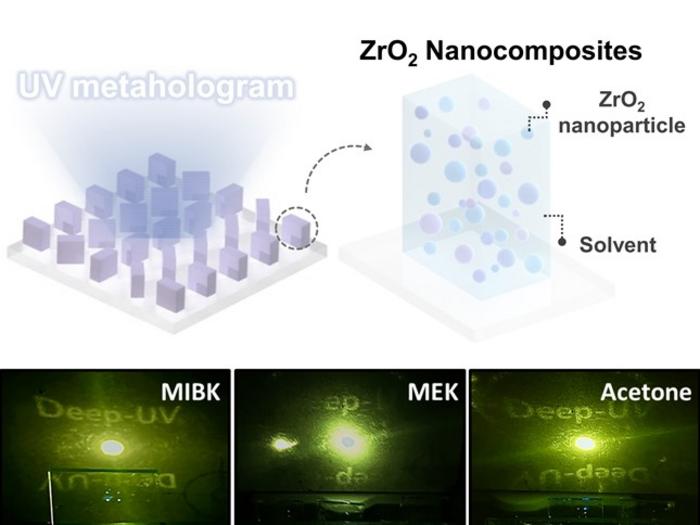| May 09, 2024 |
Discovering optimal conditions for mass production of ultraviolet holograms
(Nanowerk News) Professor Junsuk Rho from the Department of Mechanical Engineering, Chemical Engineering, and Electrical Engineering, Hyunjung Kang and Nara Jeon, PhD candidates, from Department of Mechanical Engineering and Dongkyo Oh, a PhD student, from the Department of Mechanical Engineering at Pohang University of Science and Technology (POSTECH) successfully conducted a thorough quantitative analysis. Their aim is to determine the ideal printing material for crafting ultraviolet metasurfaces.
|
|
Their findings featured in the journal Microsystems & Nanoengineering ("Tailoring high-refractive-index nanocomposites for manufacturing of ultraviolet metasurfaces").
|
 |
| Diagram illustrating the composition of nanocomposites for ultraviolet metasurface fabrication. (Top) Diagram illustrating the ZrO2 nanocomposite's role in achieving high transfer fidelity ultraviolet metaholograms. (Bottom) Comparison of UV holograms under various solvent conditions. (Image: POSTECH)
|
|
Metasurfaces, ultra-thin optical devices, possess the remarkable ability to control light down to a mere nanometer thickness. Metasurfaces have consistently been the subject of research as a pivotal technology for the advancement of next-generation displays, imaging, and biosensing. Their reach extends beyond visible light, delving into the realms of infrared and ultraviolet light.
|
|
Nanoimprint lithography is a technology in metasurface production, akin to a stamp generating numerous replicas from a single mold. This innovative technique promises affordable and large-scale manufacturing of metasurfaces, paving the way for their commercial viability. However, the resin utilized as the printing material suffers from a drawback—a low refractive index, hindering efficient light manipulation.
|
|
To tackle this challenge, researchers are actively exploring nanocomposites, integrating nanoparticles into the resin to boost its refractive index. Yet, the efficacy of this approach depends on various factors such as nanoparticle type and solvent choice, necessitating a systematic analysis for optimal metasurface performance.
|
|
In their research, the team meticulously designed experiments to evaluate the impact of nanoparticle concentration and solvent selection on pattern transfer and UV metaholograms. Specifically, they manipulated the concentration of zirconium dioxide (ZrO2), a nanocomposite renowned for its effectiveness in UV metahologram production, ranging from 20% to 90%. The findings showed that the highest pattern transfer efficiency was attained at an 80% concentration level.
|
|
Moreover, when combining ZrO2 at an 80% concentration with various solvents such as methylisobutyl ketone, methyl ethyl ketone, and acetone for metahologram realization, the conversion efficiency soared in the ultraviolet spectrum (325 nm), reaching impressive levels of 62.3%, 51.4%, and 61.5%, respectively. This research marks a significant milestone by establishing an optimal metric for achieving metaholograms specifically tailored for the ultraviolet domain, as opposed to the visible range, while also pioneering the development of new nanocomposites.
|
|
Professor Junsuk Rho from POSTECH remarked, "The use of titanium dioxide (TiO2) and silicon (Si) nanocomposites instead of ZrO2 expands the applicability to visible and infrared light." He expressed expectation by stating, "Our future research endeavors will focus on refining the preparation conditions for optimal nanocomposites, thus propelling the advancement, application and expansion of optical metasurface fabrication technology."
|

